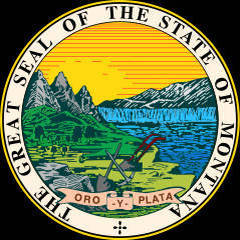
At an elevation of 3,685 ft (1,123 m) the litle town of Bridger has a present population of around 660, give or take. From a population of about 500 in 1910, Bridger steadily grew until reaching its greatest population of 854 in 1950. Thereafter it has fallen, though not steadily, until today. The first Bridger Post Office was officially established on October 29, 1898. Interestingly, while the town is named for mountain man, guide and scout Jim Bridger, townspeople originally wanted to name the town after George Town (Would it then have become Georgetown?), one of the area's original settlers, but Mr. Town encouraged residents to name the newly founded town after his old friend Jim Bridger, which they did, however reluctantly.
Originally Bridger's economic, and agricultural, base was the raising of sheep, primarily for wool production, with cattle raising and grain growing being secondary industries. While grain growing and cattle ranching remain the staples of the local economy, wool production is no longer of real importance. The most prominent structures in Bridger are its two grain elevators and a
Wool Warehouse, (now a National Register property) which appears quite similar to an elevator. In 1899, the year prior to the construction of the wool warehouse, a million pounds of wool were shipped from Carbon County. Montana was the world's leading producer of wool during the first decade of the twentieth century, and Carbon ranked ninth in contribution. In 1904 fully one-half of the assessed value of Carbon County was in cattle and sheep, and the sheep continued to out number cattle at least through the 1920s.
Among many National Register buildings within Bridger is the
Methodist Episcopal Church, dedicated on May 27, 1906. The FIRST - Church to be dedicated in the Clarks Fork Valley, it stands as an impressive example of vernacular Gothic design. Other National Register buildings include the
Heatherington Boarding House, the first boardinghouse to be erected in what is now Bridger;
Glidden Mercantile and the
Bridger Coal Company House, the OLDEST - Documented building in Bridger.
Following is the Bridger entry from the American Guide Series book,
Montana, A State Guide Book.
BRIDGER
29.1 m. (3,664 alt., 567 pop.), is a sheep and cattle town set against rimrocks (R). Oil and gas from the nearby Dry Creek and Elk Basin fields have materially siowed down production in its once important coal mines. Bridger might well be the faded original of some frontier town described in fiction. The town was named for the greatest frontiersman in western history; the proof of his skill lies in the fact that though he was in the fur trade in 1810, he lived to be a very old man.
From Montana, A State Guide Book, Page 339